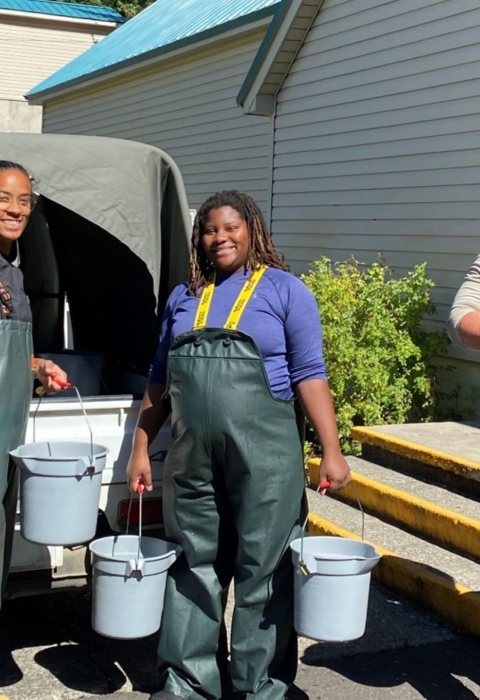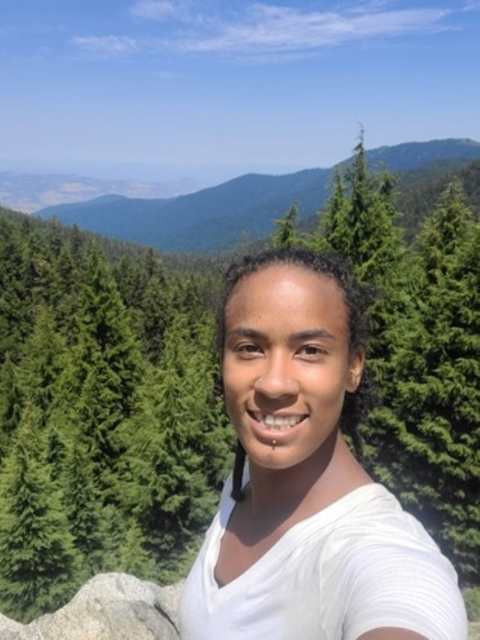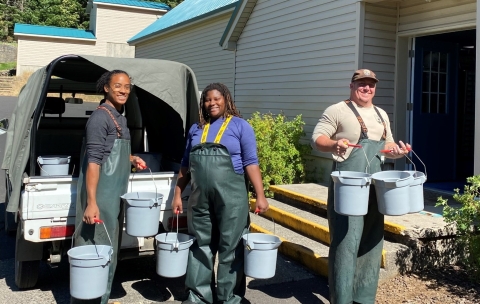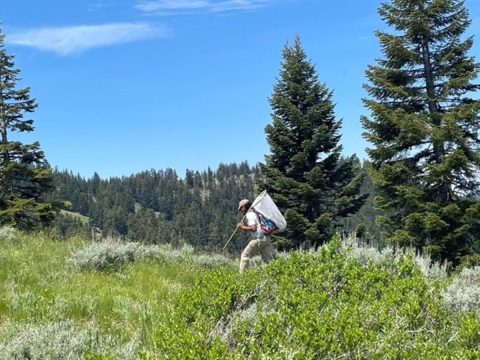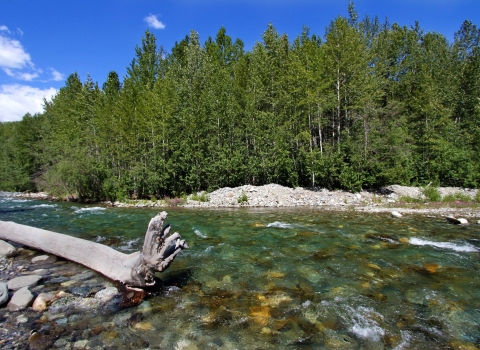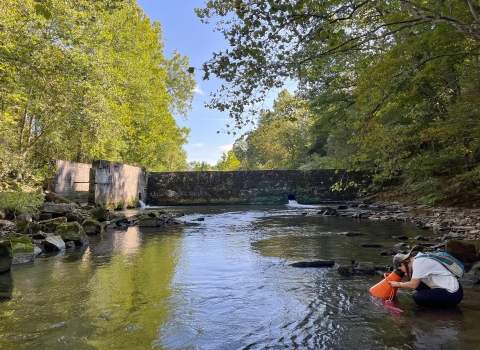This summer, the U.S. Fish and Wildlife Service (Service) Science Applications Program had the pleasure of hosting Venecia Rollins as their MANRRS (Minorities in Agriculture, Natural Resources and Related Sciences) intern.
Originally from Wisconsin, Rollins has called Oregon home since 2017. After taking almost a decade off from school to work and travel the world, Rollins started her undergraduate degree at Oregon State University. There, she is pursuing degrees in both Sustainability and BioResource Research with concentrations in Water Resources and Toxicology. After graduating with her degree, Rollins plans to complete an accelerated master’s program in Water Resource Engineering.
When she is not studying, Rollins spends as much time as possible camping, hiking, kayaking and foraging for mushrooms in the forests of Oregon. She also loves to volunteer, go SCUBA diving, make pottery, and grow heirloom vegetables.
Rollins answered a few questions about herself and her summer internship experience.
1. What are three words you’d use to describe yourself?
Three words I would use to describe myself are: goofy, mindful, and motivated.
2. What did you do during your summer internship?
This summer was packed to the brim with adventure and new experiences. I had the opportunity at Tualatin River Wildlife Refuge to survey fields for checker mallows, plant trees in a wetland, sit in on community-building talks, and map invasive species invasive species
An invasive species is any plant or animal that has spread or been introduced into a new area where they are, or could, cause harm to the environment, economy, or human, animal, or plant health. Their unwelcome presence can destroy ecosystems and cost millions of dollars.
Learn more about invasive species in a dry lakebed.
I also got to spend one week attending the Hawaii Conservation Conference, learning a plethora from elders and researchers, alike. Additionally, I constructed the virtual booth for USFWS Science Applications at the conference and put together a template for use on Hawaiian refuges.
One week was spent surveying bumblebees on Mount Ashland, with the hope of finding the elusive Franklin’s Bumblebee. This was also a great networking opportunity with Service employees.
I attended over 15 webinars made available to USFWS employees my favorites being: the AEEW 2022 — Session #3 — The Use of Science & Traditional Knowledge and last week’s Environmental Justice Community of Practice Opening Session.
When working from the office, my days were spent entering over 2000 data points for a geospatial pollinator database of western states in the United States for future use.
My internship concluded with spawning season at both Little White Salmon and Carson Fish Hatcheries, aiding in the collection of water samples and performing micron filtration for New Zealand mud snail eDNA testing. I spent a day at the North Klaskanine Fork Dam Removal and River Restoration project, visited the Oregon Zoo to meet with biologists about salmon eggs for their new educational salmon life cycle display, and visited the Abernathy Fish Technology Center.
3. This summer, you completed your internship with the Service in partnership with the MANRRS program. What does MANRRS mean to you?
MANRRS is a non-profit national organization that I did not know existed until I started school at Oregon State in Fall 2021. I was looking for a community at school where I could be myself, feel supported and hopefully support others.
Last year during spring break, I had the opportunity to attend the National MANRRS Conference in Jacksonville, FL and everything changed. To be in a room with over 1000 other minority students all pursuing STEM fields was an incredible feeling. It was a feeling of pride, strength, and joy that I had never felt before.
Since then, I have remained an active member of MANRRS at OSU and this upcoming school year am very much looking forward to being our Chapter’s Vice President. My goal is to help other BIPOC (Black and Indigenous People of Color) students, particularly ones who are from large and diverse cities who find themselves in the predominately monocultural dorms of Oregon State to find community with others who may look more like them or have backgrounds more like theirs. I want to help curate a space on campus these students feel at home and safe, feel lifted up and encouraged to explore paths they may have never thought of before and overall, just feel like they have someone in their corner supporting them at school.
MANRRS gives me more than anything the encouragement to keep going. Though perhaps individually each BIPOC student or young professional pursuing a career in a STEM field may feel like they are the only one like them in the day-to-day, being part of MANRRS reminds [us] all we are not alone, we are not the only one, and that together, we are changing the world.
4. What is one of your favorite memories from your internship this summer?
One of my favorite memories from my summer MANRRS internship has got to be the Bumblebee Blitz on Mount Ashland. It was such an incredible experience to learn not only about bees in the Bombus genus, but also to have a real chance to build bonds with several Service Directorate Fellows, make connections with Service employees stationed throughout Oregon, Washington, and California, and hear so many different stories about how each of them got into the service and found their niche. It was truly an inspiring week, and I am so happy I got to be part of it. Plus, who doesn’t want to get paid to go camping and walk around on the Pacific Crest Trail surrounded by fields of wildflowers all the while looking for an elusive bumblebee?
5. Did anything surprise you about the U.S. Fish and Wildlife Service?
One thing that really surprised me about the Service is that I can see myself working here! Never in my life prior to this internship had I thought there was a path in which I would want to work in a federal position. The community and the mission of the Service really made me feel like I had found a place where I can be myself and work with others toward the achievement of some extraordinary goals. I look forward to applying for the Directorate Fellows Program with the Service for summer 2023.
6. What are your career goals?
Regarding my career goals, I still haven’t made up my mind about whether I would like to pursue research or engineering, so I figure I’ll do both. Because of this, the Service seems like a really great place to point my arrow toward. I know that no matter what, conservation, water resources, and environmental justice are most important to me and just as important to everyone else I have met through this internship. I could see myself working in river restoration from either an engineering standpoint or an environmental justice standpoint, so I figure, with a master’s in water resource engineering, I approach from whichever facet works best at any time.
7. Do you have any advice or words of wisdom for other future MANRRS Interns?
Some advice I would love to give other students includes:
- Talk to everyone: everyone has a story to tell
- Love yourself without terms and conditions
- Create the world you dream about. You’re the only one who can
- You have two ears and one mouth for a reason
- Find what drives you and lean into it with all you’ve got
- If you are nervous, you’re probably in the right place
- If they don’t support you, there is no room for them
- Treat yourself like you do your best friend
- Nothing worth doing is every easy and whether it’s been done before or not doesn’t matter when you stop comparing yourself to others
- Dream BIGGER and then… Dream BIGGER 😊
- I Believe in you.
